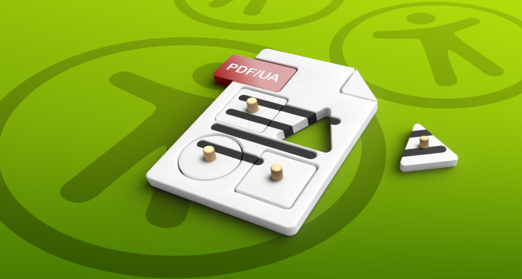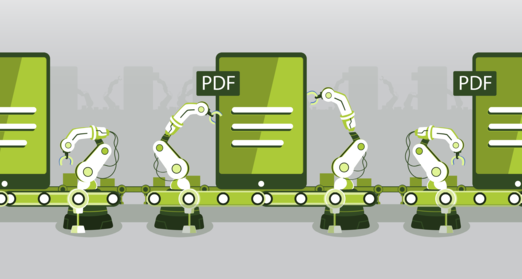
PDF/UA-2 vs. Well-tagged PDF

Two new standards that define the accessibility of PDF files were released almost simultaneously: ISO 14289-2:2024, also known as PDF/UA-2, on March 15, 2024, and Well-Tagged PDF at the end of February. We would like to provide a first overview.
Which standard applies to PDF accessibility?
To have a better understanding of the two new standards for PDF accessibility, we will have a look at the following questions:
- What are the differences between PDF/UA-2 and Well-Tagged PDF?
- Is PDF/UA-2 the successor to PDF/UA-1?
- What should you already know about PDF/UA-2?
- What advantages does PDF/UA-2 offer?
- When does it make sense to switch to PDF/UA-2?
Before answering these questions, let's first clarify a few key terms.
Tagged PDF, the origin
Tagged PDF is a mechanism introduced in 2001 with PDF 1.4 to enable PDF to meet the needs of modern content formats. These include content extraction and reuse, as well as full accessibility. The mechanism has evolved through various PDF versions to its current form, described in the 2017 PDF 2.0 specification.
PDF/UA-1, the “top dog”
PDF/UA-1 is the currently dominant standard that defines the requirements for an accessible PDF based on specific PDF features and mechanisms from the PDF specification ISO-32000-1 (PDF 1.7). It was first published as ISO 14289-1:2012 in August 2012 and has since become a DIN standard.
It is important to note that the PDF specification dictates the set of standard PDF tags and additional features that are available. The corresponding UA standard only regulates their use.
From the beginning, PDF/UA-1 was designed to complement other standards - such as the Web Content Accessibility Guidelines (WCAG) - by referencing them for requirements that do not require PDF-specific implementation. One example is the contrast requirement.
It is important to note that PDF/UA not only specifies how an accessible PDF must be technically implemented but also ensures that there is reliable interaction between authoring tools, the document itself, and viewer and assistive software.
The development of PDF/UA-1 is closely linked to the creation of the standard for archival PDFs, PDF/A, and as a result PDF/UA has some requirements from an accessibility perspective that may not be immediately intuitive.

PDF/UA-2, the newcomer
PDF/UA-2 addresses the shortcomings of PDF/UA-1. The focus during its development was entirely on accessibility. Another goal was to limit the standard to PDF-specific requirements, leaving all content-related requirements (such as comprehensibility) to other standards.
PDF/UA-2 regulates the use of concepts and mechanisms from the PDF specification ISO 32000-2 (PDF 2.0). These include:
- Introduction of the namespace concept: A PDF/UA document can now contain multiple tag sets to leverage the semantic markup capabilities of other structured formats for PDF, such as MathML or EPUB.
- Enhancement of the standard tag set to include, for example, Title, Aside, Sub, or DocumentFragment to provide richer semantics.
- Enhanced ability to mark items as artifacts, such as annotations, or using the new artifact tag.
- Additional attributes that provide machine-readable access to layout information with semantic meaning.
At least on paper, PDF/UA-2 offers the potential for a richer and more reliable user experience for people who rely on accessible documents.
Well-Tagged PDF, the twin
However, accessibility is not the only application for the concepts and mechanisms addressed by PDF/UA-2. The original aim of the Tagged PDF mechanism was to enable extracting and reusing content. But even for that purpose, a PDF must meet certain quality criteria for tags. An international working group from the PDF Association developed a standard named Well-Tagged PDF with two conformity levels:
- Conformity level: For reuse
- Conformity level: For accessibility
The conformity level 2 of the Well-Tagged PDF standard is identical to the PDF/UA-2 requirements. A large portion of the content, such as the descriptions of the tag types, are exactly the same.
What are the differences between PDF/UA-2 and Well-Tagged PDF?
Even though PDF/UA-2 and Well-Tagged PDF are identical in terms of the conformity level "For accessibility," there are differences:
- PDF/UA-2 is an official ISO standard, while Well-Tagged PDF is a standard from the PDF Association.
- The Well-Tagged PDF specification is available on the PDF Association's website for free, while PDF/UA-2 must be purchased. This is a major advantage because: If someone wants to learn PDF/UA-2, they can simply work through Well-Tagged PDF with the "For accessibility" conformity level.
Update: Since August 12, 2024, all PDF/UA standards are available as "no cost" versions on the PDF Association website. This has been made possible because four companies, including axes4, sponsored this project: https://pdfa.org/announcing-no-cost-access-to-pdfs-accessibility-standards/
Is PDF/UA-2 the successor to PDF/UA-1?
No. PDF/UA-2 is completely rewritten based on the PDF specification 32000-2. PDF/UA-1, on the other hand, is based on PDF 32000-1. They represent two entirely different worlds, even though the newcomer has adopted some elements from PDF/UA-1.

What should you already know about PDF/UA-2?
PDF/UA-2 introduces a so-called "breaking change": a conceptual change to a standard that makes backward compatibility impossible. Although a PDF/UA-2-compliant document can still contain the PDF/UA-1 namespace, compatibility with older versions is not guaranteed.
When does it make sense to switch to PDF/UA-2?
The key to establishing a new standard lies in the PDF viewers: A switch is only worthwhile once PDF viewers not only support reading PDF/UA-2 files but also the potential of the new features. This also depends on the fact that assistive software relies on the data it receives from the PDF viewer. Only when this chain of interaction is guaranteed can the improvements for the accessible user experience reach the users.

Conclusion
When it comes to the standard for PDF accessibility, the question is not whether to adhere to PDF/UA-2 or Well-Tagged PDF. Both standards are identical in terms of accessibility.
The more important question is when to adopt PDF/UA-2 over PDF/UA-1, since backward compatibility is not possible. PDF/UA-2 offers great potential for an optimized accessible user experience, and not just because of the namespace concept. However, for these benefits to reach users, PDF viewers must support them and pass the data to assistive software.
Especially for software developers and remediators, it is already worthwhile to familiarize themselves with the PDF/UA-2 world and create an implementation plan. The Well-Tagged PDF specification is ideal for this. It is available free of charge.
We will be discussing specific aspects of PDF/UA-2 more in the coming months.
Useful links
For those interested in learning more, the links below provide easy access to additional resources. All documents related to PDF accessibility standards are available free of charge, and some are offered as sponsored "no cost" versions. Please note that all content is provided in English only.
- PDF 32000-1: https://opensource.adobe.com/dc-acrobat-sdk-docs/pdfstandards/PDF32000_2008.pdf
- PDF/UA-1: https://pdfa.org/announcing-no-cost-access-to-pdfs-accessibility-standards/
- Tagged PDF Best Practice Guide (PDF/UA-1): https://pdfa.org/wp-content/uploads/2023/07/Tagged-PDF-Best-Practice-Guide.pdf
- Techniques für PDF-Accessibility (PDF/UA-1): https://pdfa.org/pdf-techniques-for-accessibility-a-new-model/
- PDF 32000-2: https://www.pdfa-inc.org/product/iso-32000-2-pdf-2-0-bundle-sponsored-access/
- PDF 32005: https://pdfa.org/resource/iso-32005/
- PDF/UA-2: https://pdfa.org/announcing-no-cost-access-to-pdfs-accessibility-standards/
- Well Tagged PDF: https://pdfa.org/wtpdf/
- Tagged PDF: Q&A: https://pdfa.org/resource/tagged-pdf-q-a/

